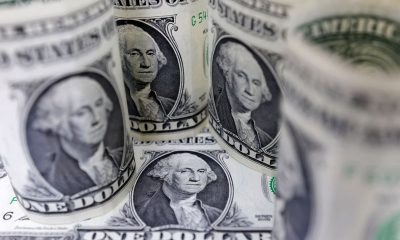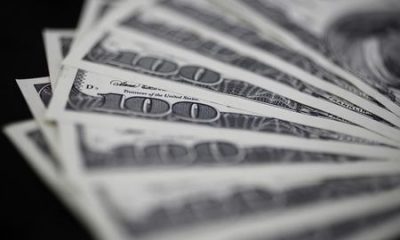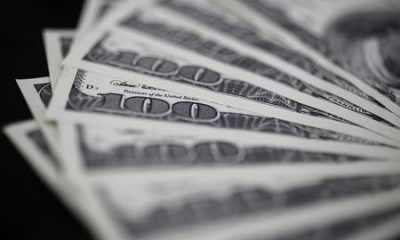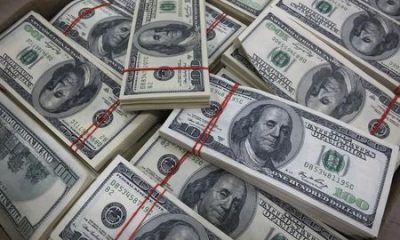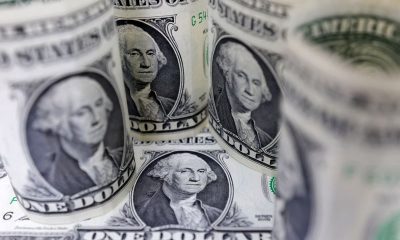Forex
Dollar holds near 5-week peak as Fed rate cut bets tempered

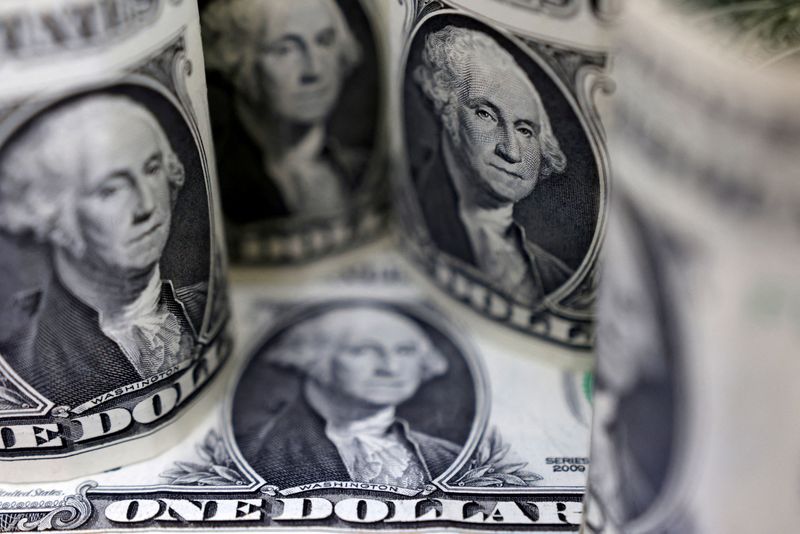
© Reuters. FILE PHOTO: U.S. Dollar banknotes are seen in this illustration taken July 17, 2022. REUTERS/Dado Ruvic/Illustration/File Photo
By Samuel Indyk and Kevin Buckland
LONDON (Reuters) -The dollar hovered near a five-week peak against major peers on Thursday after robust U.S. retail sales data added to expectations the Federal Reserve will not rush to lower interest rates.
The , which measures the currency against a basket of six rivals, was steady at 103.34 in Europe, after reaching 103.69 on Wednesday for the first time since Dec. 13.
Traders have trimmed the odds of a first Federal Reserve rate cut by March to 61%, from over 65% on Tuesday, according to CME’s FedWatch Tool.
The market is still pricing in around 145 basis points of cuts by the end of the year, even as Fed officials including Governor Christopher Waller this week pushed back against expectations of rapid policy loosening.
“U.S. data has been a mixed bag but yesterday we got a very strong retail sales report indicating that there is no need to be too aggressive on rate cuts,” said Niels Christensen, chief analyst at Nordea.
“Lower rate cut expectations and risk-off sentiment is positive for the dollar,” Christensen added.
The dollar pushed as high as 148.525 yen on Wednesday for the first time since the end of November.
It was last trading 0.2% lower on the day at 147.895 yen. At the end of last week, though, it was as weak as 144.35 yen.
Investors have been steadily pricing out hawkish Bank of Japan wagers, not least due to the devastating New Year’s Day quake in central Japan. The BOJ meets on policy on Monday and Tuesday of next week.
“I think dollar-yen is going to be floating between 145 and even 150 in the near term,” a level last seen in mid-November, said Shoki Omori, chief Japan desk strategist at Mizuho Securities.
Should the BOJ stick to its dovish message next week, and if Fed Chair Jerome Powell strikes a similar posture to Waller at the U.S. central bank’s policy meeting on Jan. 30-31, the dollar could push beyond 150 yen by the start of February, Omori said.
“Japanese officials could start to come in and verbally intervene at any time now” to try and slow the yen’s decline, he added.
The euro () was little changed at $1.0880 after the accounts from the European Central Bank’s December meeting offered few clues about the timing of the first rate cut.
The single currency had bounced from a five-week low of $1.08445 on Wednesday, supported by ECB President Christine Lagarde’s comments to Bloomberg that there would likely be majority support among ECB officials for an interest rate cut in the summer, later than market expectations for a spring cut.
Sterling was also flat at $1.2676, following a rally on Wednesday after data showed inflation unexpectedly accelerated in December, reinforcing expectations the Bank of England will be slower to cut rates than its peers.
The British currency’s 0.3% jump on Wednesday snapped a three-day decline against the greenback, and limited Wednesday’s gains for the , of which sterling is a part.
The Australian dollar was up 0.2% at $0.6566, recovering from losses as steep as 0.4% to $0.65255 earlier when data showed an unexpected drop in employment in December, adding to the case that rates have peaked in the country.
“There’s clearly some technical support around $0.6520 which bears are hesitant to short above,” said Matt Simpson, senior market analyst at City Index.
“Yet the jobs report doesn’t provide any meaningful reason to be long AUD,” he added. “And that means its next directional move remains in the hands of Fed expectations, and therefore the U.S. dollar.”
Forex
BofA sees potential for further USD selling by CTAs
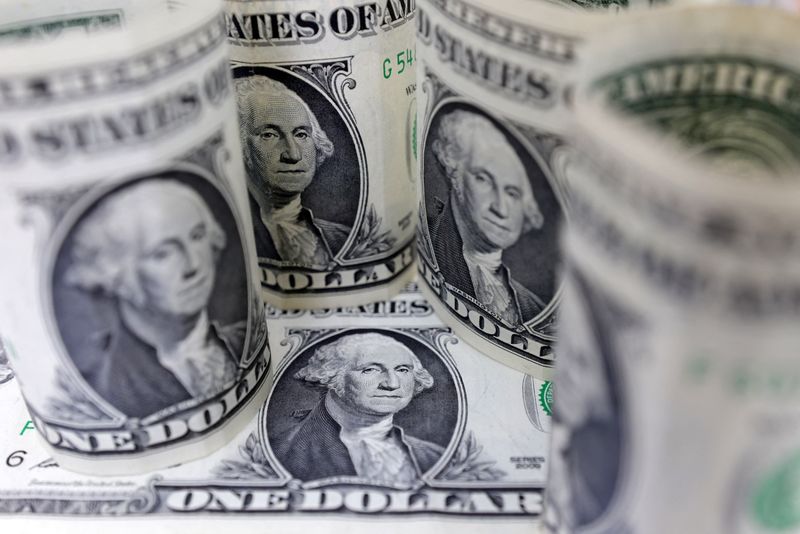
On Monday, Bank of America (BofA) provided insights into the potential actions of Commodity Trading Advisors (CTAs) in the coming week.
According to BofA, CTAs might continue to sell the U.S. dollar (USD) against most currencies following a trend that emerged after the Consumer Price Index (CPI) report led to a weakening dollar. The bank’s models indicate that USD long positions have been reduced this week.
The bank’s analysis suggests that in the foreign exchange (FX) market, CTAs are likely to persist with short covering in the euro (EUR), British pound (GBP), and Canadian dollar (CAD).
Additionally, there is an expectation for CTAs to increase their recently established long positions in the Australian dollar (AUD) and potentially initiate a long position in the Mexican peso (MXN), given the positive trend strength for the peso.
In the commodities sector, despite an increase in the price of gold last week, the trend for the precious metal declined, prompting CTAs to sell, albeit at a slower pace. BofA anticipates that this trend of selling gold and oil will continue into the next week.
The analysis also noted that CTAs’ long positions in are nearing extremely high levels, while long positions in aluminium are being unwound. In contrast, soybeans are experiencing short covering.
The bank’s report serves as a gauge of how trend-following traders might adjust their portfolios in response to market movements.
This article was generated with the support of AI and reviewed by an editor. For more information see our T&C.
Forex
BofA sees further dollar depreciation, expects G10 FX to stay in range
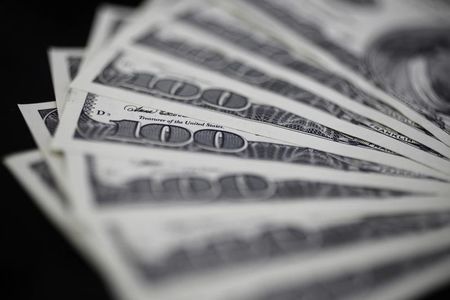
On Monday, Bank of America (BofA) analysts provided insights into the current state of G10 foreign exchange (FX) markets, noting a general sentiment of disappointment among investors due to the markets’ lack of volatility.
Despite a recent reversal in the U.S. dollar (USD), major currency pairs have not moved significantly, staying within their established ranges. BofA anticipates further depreciation of the USD, yet it emphasizes that the currency’s movements are expected to remain close to year-end consensus forecasts.
The analysis highlighted that while markets have expressed a desire for more excitement in G10 FX trading, they must come to terms with the inherent trade-off between carry trade opportunities and higher volatility. Carry trades, where investors borrow in low-yielding currencies to invest in higher-yielding ones, have been identified as a dominant trend post-global financial crisis.
However, this strategy tends to reduce market volatility, leading to what BofA describes as an “uninspiring” and “stuck in the mud” trading environment.
BofA’s commentary suggests that the pursuit of carry as a passive strategy has been a factor in dampening volatility in the FX markets. The firm underscores that investors should not expect both high carry returns and high volatility, as these market conditions are typically mutually exclusive. The lack of clear fundamental trends in G10 FX has been a source of frustration for markets, but the current trend of carry is clear, even if it leads to lower volatility.
The analysts also touched upon the anticipation around the next batch of U.S. data, which many investors hope might shift the narrative. However, BofA indicates that such expectations may be overly optimistic. The firm’s message to the markets is to adjust expectations and accept the current dynamics, with the USD continuing to play a central role in the G10 FX space.
In summary, BofA’s analysis points to a continuation of the recent patterns in G10 FX markets, with a slight downward trend in the USD value but within the bounds of recent trading ranges.
This article was generated with the support of AI and reviewed by an editor. For more information see our T&C.
Forex
Narrow dollar range likely to remain for now – Goldman
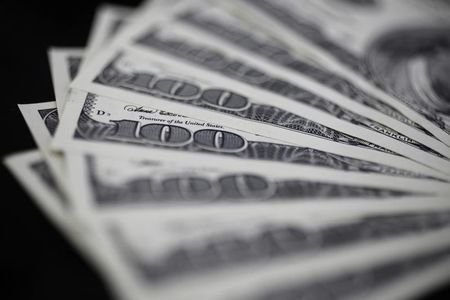
Investing.com – The U.S. dollar is trading in a calm fashion against the majors of late, and these narrow ranges will likely stay for a while longer, according to Goldman Sachs, with divergence having to wait.
AT 05:20 ET (09:20 GMT), the Dollar Index, which tracks the greenback against a basket of six other currencies, traded unchanged at 104.330, steadying after losing around 1% last week in the wake of soft U.S. inflation data.
“We think there is only limited room for the market to press Dollar shorts on the back of the inflation news,” said analysts at Goldman Sachs, in a note dated May 17.
“After all, while the prints were mostly in line with expectations, they were not in line with the target. As a result, the news does not change the policy outlook much beyond reinforcing the recent rhetoric.”
The subsequent market response has been reminiscent of the post-March FOMC FX reaction, when the response to ‘dovish dots’ stalled not because of fresh data, but instead because FX is still a relative game, and the Dollar fundamentals have not shifted much, the investment bank added.
And, this time around, we think the rally in front end rates looks more consistent with cyclical concerns rather than dovish expectations.
“That matters for FX because there is a narrow path for the Dollar to depreciate on a broad basis when growth is softening,” the bank added. “This is especially true in the current environment when faster Fed cuts would likely be met with easier policy abroad as well.”

 Forex2 years ago
Forex2 years agoForex Today: the dollar is gaining strength amid gloomy sentiment at the start of the Fed’s week

 Forex2 years ago
Forex2 years agoHow is the Australian dollar doing today?

 Forex1 year ago
Forex1 year agoUnbiased review of Pocket Option broker

 Forex2 years ago
Forex2 years agoDollar to pound sterling exchange rate today: Pound plummeted to its lowest since 1985

 Cryptocurrency2 years ago
Cryptocurrency2 years agoWhat happened in the crypto market – current events today

 World2 years ago
World2 years agoWhy are modern video games an art form?

 Stock Markets2 years ago
Stock Markets2 years agoMorgan Stanley: bear market rally to continue

 Economy2 years ago
Economy2 years agoCrude oil tankers double in price due to EU anti-Russian sanctions

